On June 4th, 2022, a seminar themed historical cities and architectural heritage in the Trans-Himalayan region was held at the Cheery Canal Hotel in Hangzhou, China. The conference was hosted by the Zhejiang University City College and organized by the School of Land and Space Planning of Zhejiang University City College. It is aimed to share the expertise and experience of scholars from various nations in the cultural heritage field through academic exchanges of historical cities and architectural heritage research in the trans-Himalayan region, and promote the construction of the theoretical system of Asian cities and architecture together with the development of cultural heritage management methodologies in the Asian context.
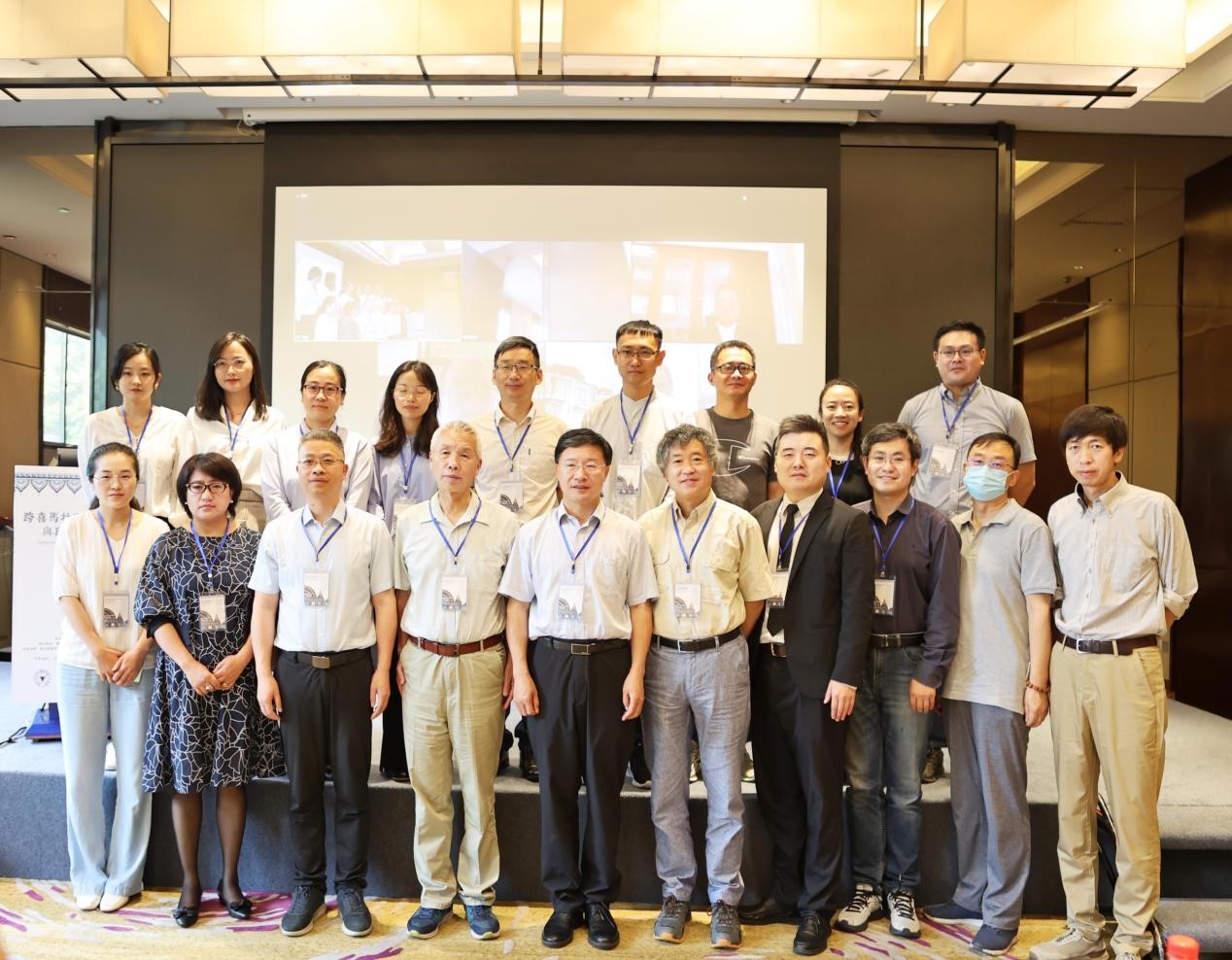 |
| Fig. 1 Group Photo of Guest Speakers Invited |
The symposium, which consists of keynote speeches, comment and discussion sessions, was held both offline and online. 15 invited speakers and other participants of this field at home and abroad joined the symposium. To be specific, the keynote speakers included Dr. Cheng Yue (First Class Inspector of the Academy of Social Sciences of the Tibet Autonomous Region of China), Professor Wang Yongping (College of Architecture, Nanjing Tech University), Associate Professor Neel Kamal Chapagain (Center for Heritage Management, Ahmadabad University, India), Professor Dong Wei (Department of Urban Planning, School of Architecture, Southeast University), Professor Saswat Bandyopadhyay (Faculty of Planning, CEPT University, India), Research professorship Wang Ruilei and Ph.D candidate Wang Zonghui (Zhejiang University Center for Buddhist Art & School of Art and Archaeology of Zhejiang University), Professor Suolang Baimu (Institute of Technology, Tibet University) and Dr. Wang Xihui (Department of Architecture, School of Spatial Planning and Design, Zhejiang University City College), Professor Md. Masood Imran (Department of Archaeology, Jahangirnagar University, Bangladesh), Dr. Bob Hudson (Asian Studies Program, University of Sydney, Australia).
The speakers’ research fields vary from architecture and urban planning to art history and archaeology. Themes discussed include the historical urban system and urbanization of the Qinghai-Tibet Plateau, Tibetan traditional architecture, Tibetan Buddhist architecture, trans-Himalayan settlement archaeology, cultural heritage conservation, etc. In the commentary and dialogue session after every report, the invited speakers spoke freely, which triggered the exchange and collision of academic viewpoints in the heated discussion, and the participants benefited a lot both online and offline.
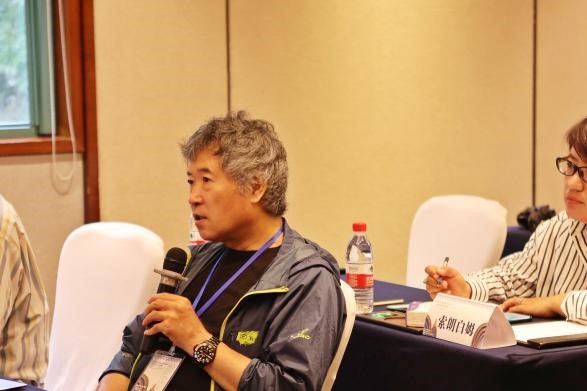 |
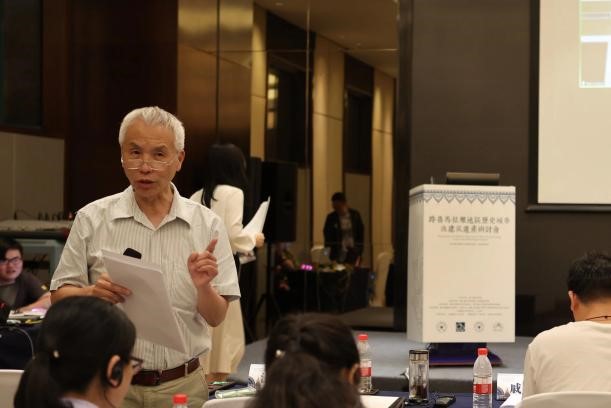 |
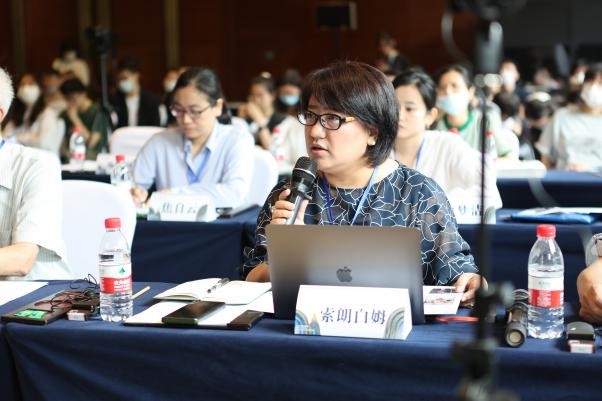 |
 |
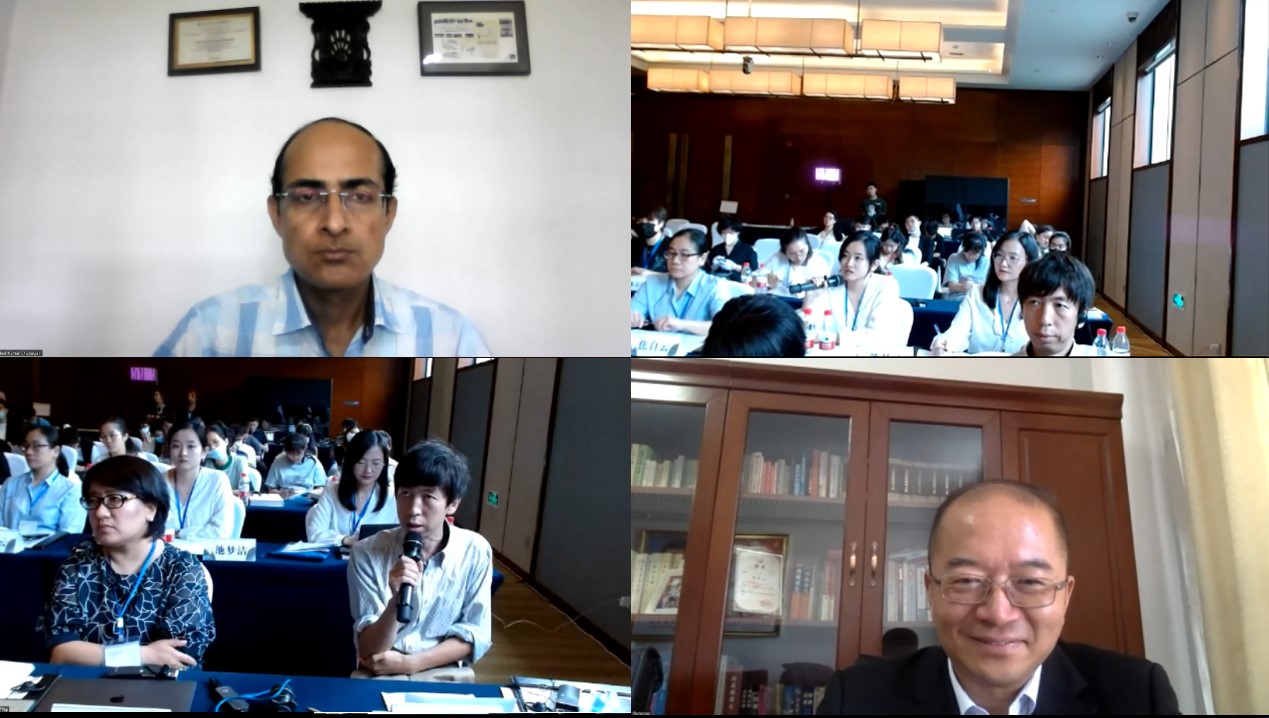 |
| Fig.2 Comment and Discussion Session |
Below is a summary of the key points of each speaker’s report:
1. Cheng Yue, Major Achievements and Historical Experience of the Communist Party of China in Governing Tibet
 |
| Fig.3 First Class Inspector, The Academy of Social Sciences of the Tibet Autonomous Region of China Cheng Yue is Giving Online Report |
In addition to summarizing the major achievements and historical experience of the Communist Party of China (CPC) in governing Tibet, Dr.Cheng pointed out the future development direction and ideas. Firstly, the major achievements made by the CPC in four historical periods of governance of Tibet, especially the achievements in infrastructure construction, urban planning, industrial production system construction and agricultural and animal husbandry development, are outlined. Secondly, Dr.Cheng summarized the valuable experience and historical significance of the CPC’s 72-year governance in Tibet. Lastly, key practical suggestions for building a beautiful and happy Tibet are put forward, including putting political construction in the first place, adhering to the leadership of the CPC, taking the building of the Chinese national consciousness as the main line, taking the new industrialization as the leader, adopting the common prosperity of beautiful Tibet as the goal, and unswervingly promoting the new urbanization and ecological development. In order to attain these goals, it is proposed to establish “one-hour economic circle around Lhasa”, the Lhasa-Shannan economic corridor and the “three-hour economic circle” covering Nyingchi, Shigatse and Nagqu, incorporate Tibet in the overall scope of the Yangtze River Economic Belt, promote interdisciplinary cooperative research, give full play to the role of universities and research institutions as national think tank bases, and further strengthen the consciousness of the Chinese nation as a community.
2. WangYongping, Walking into the Himalayas: Exploration of the Himalayan Cities and Architectural Culture
 |
| Fig.4 Professor Wang Yongping from College of Architecture, Nanjing Tech University is Giving Report |
The reporter introduced the theme from the overview of the Himalayas, and stressed the important role of the region in connecting South Asia and Tibet through physical geography and religious culture, especially Buddhist culture. Firstly, taking the expression of Buddhist culture in architecture and cities as an example, the reporter pointed out the diversity and unity in the Himalayan cultures. Secondly, a literature review on the urban and architectural research of the Himalayas at home and abroad was made. Lastly, the reporter introduced his team’s research of Tibetan architecture in inheriting the ideals of oriental architecture research of the former educational masters Liang Sicheng and Mr. Liu Dunzhen, including the rich first-hand materials by surveying and mapping since 1999, and a series of monographs such as the series of
Himalayan Cities and Architecture and
History of Tibetan Buddhist Architecture. He has also guided some master and doctoral theses, and published a number of academic papers, which fully reflects the perspectiveness, continuity and academic value of Prof.Wang Yongping’s work.
3. Neel Kamal Chapagain, Cultural Landscapes Approach for the Region of Historic Settlement of Lomanthang of the Upper Mustang in Nepal
 |
| Fig.5 Associate Professor Neel Kamal Chapagain From Center for Heritage Management, Ahmadabad University, India is Giving Report |
Luomantang, the medieval capital of Mustang, Nepal, and is listed as a World Cultural Heritage city. By taking Luomanthang as an example, Associate Prof.Neel Kamal Chapagain discussed the cultural landscape approach in urban heritage conservation. He pointed out that the uniqueness of Luomantang lies in the continuation of its architectural traditions which is closely related to the terrain, hydrology, economy, social order and multicultural traditions of the place. In recent years, however, Luomantang has also faced the situation that the architectural heritage management cannot keep up with the changes in the natural environment and socioeconomic development. The problem is rooted in the lack of humanistic perspective and holistic view in heritage conservation. Therefore, a method of integrating cultural landscapes and historical urban landscapes has been proposed, and it’s worth noting that the historic city should be regarded as a dynamic and evolving multi-level space linked to the natural environment, the built environment, and the humanity environment. The most important thing is not to conserve the heritage itself, but to maintain long-term and sufficient communication with the local people. Only in this way can a balance between heritage conservation and sustainable development be achieved.
4. Dong Wei, A Preliminary Study on the Spatial Pattern of Historic Cities on the Qinghai-Tibet Plateau
 |
| Fig.6 Professor Dong Wei, Department of Planning, School of Architecture, Southeast University is Giving Report |
From the perspective of the spatial evolution of regional settlements and urban clusters, Prof. Dong Wei summarized the regional characteristics of settlements on the Qinghai-Tibet Plateau, and raised a systematic research plan for conserving the cultural heritage of the Qinghai-Tibet Plateau and building a plateau city alliance. The settlements on the Qinghai-Tibet Plateau present a cluster effect under the cooperative development of multiple civilizations and the comprehensive influence of multiple factors. In order to avoid fragmented conservation of cultural heritage, the research of settlements and cities on the Qinghai-Tibet Plateau should adhere to a holistic and systematic view. Firstly, the Qinghai-Tibet Plateau is characterized by the integration of natural ecological units and social and cultural units. It is also essential to learn from the experience of our ancestors in dealing with the relationship between settlements, cities and landscapes and other natural environments. Secondly, the law of urban and settlement development needs to be studied from the perspective of interdisciplinary research, the historical urban-rural system of the Qinghai-Tibet Plateau should be reconstructed, and a new mode of conservation and utilization of natural and cultural heritage should be innovated. Finally, it is proposed to integrate the cultural sites in the Qinghai-Tibet Plateau based on historical routes and corridors, establish the settlement and urban system of the Qinghai-Tibet Plateau, and make continuous improvement, so as to gain a more complete and true reflection of the urban and rural history and achieve the purpose of constructing “National Historic Space”.
5. Saswat Bandyopadhyay, Inclusive Heritage Based City Development Programme: Lessons From Indian Historic Cities
 |
| Fig.7 Professor Saswat Bandyopadhyay, Faculty of Planning,CEPT University is Giving Report |
India is a country with rich and diverse cultural heritage resources, nowadays, its urban heritage is facing both opportunities and challenges. In terms of the challenge, India is undergoing rapid urbanization, and there are many contradictions in the urban heritage conservation, including the deterioration of infrastructure and environment, entrenched poverty in the historic urban center, and the demolition of a large number of historic buildings in urban renewal projects. In addition, the practice of cultural heritage management has always focused on preservation or conservation, ignoring the need for development, and the current heritage management administration system is too complicated to make the authorities and responsibilities clear. In terms of the opportunity, many historic cities have a rich substantial architectural heritage and traditional handicrafts. Moreover, being in the early stage of urbanization offers India an opportunity to explore a paradigm shift. In response to the challenge, the presenter proposed a practical approach to participatory heritage management based on the principles of inclusive urban heritage management. According to Prof. Saswat Bandyopadhyay, the government should play a leading role in heritage mapping and database construction, and at the same time cooperate with multi-stakeholders to map, classify and evaluate urban heritage resources. And then combined with several urban cases, the application value and effect of this approach are expounded. Finally, it is proposed to link the urban evolution with the process of socioeconomic development, so as to promote the transformation of a new paradigm of interaction between heritage conservation and sustainable development.
6. Wang Ruilei, Wang Zonghui, The Relationship Between the Architectural Forms of "Cruciform Structure" and the "Laternendecke Ceiling" of Early Buddhist Temples in Western Himalayas and that in Central Asia
 |
| Fig.8 Ph.D candidate Wang Zonghui , Zhejiang University Center for Buddhist Art & School of Art and Archaeology of Zhejiang University, Representative of Research Team of Research Professorship Wang Ruilei, is Giving Report |
From the late 10th century to the early 12th century, an architectural form of "Cruciform Structure" and the "Laternendecke Ceiling" of Buddhist temples suddenly emerged at the "mngav-ris-skor-gsum" centered on the Gurge Kingdom in the west of Tibet. This architectural form is of great significance for exploring the composition of the ancient Buddhist temples in mngav-ris-skor-gsum and the international cultural communication between this area and the outside world. Based on the investigation of the origin of the "Cruciform Structure", it is determined that it has appeared in central and eastern Tibet as early as the Tubo dynasty. During the Tubo period, the origin of such a building style can be traced back to the esoteric monasteries centered on Vikramasilavihara in East India. However, in order to continue tracing the root from the perspective of archaeological cultural genealogy, our focus must be shifted to Central Asia and the ancient Gandhara region. In the 2nd to 3rd century AD, in Northwest India and Central Asia, the first practice of the "Cruciform Structure" Buddhist architectural form appeared. With the culture spreading itself eastward along the Silk Road, it has influenced the architectural form of Buddhist temples in Xinjiang and other regions of China. In addition, the "Cruciform Structure" was found to be first used in dwellings of Central Asia. Meanwhile, this architectural form of the ancient mngav-ris-skor-gsum also appeared in architectural spaces such as palaces and fortresses. Therefore, from an overall perspective, it can be preliminarily inferred that the "Cruciform Structure" buildings in the mngav-ris-skor-gsum in the early 11th and 12th centuries should be more influenced by adjacent areas such as Pakistan and Central Asia. The applications of "Laternendecke Ceiling" in these buildings also testify the above point.
7. Suolang Baimu, A Study on the Conservation of Architectural Heritage in Mustang, Nepal
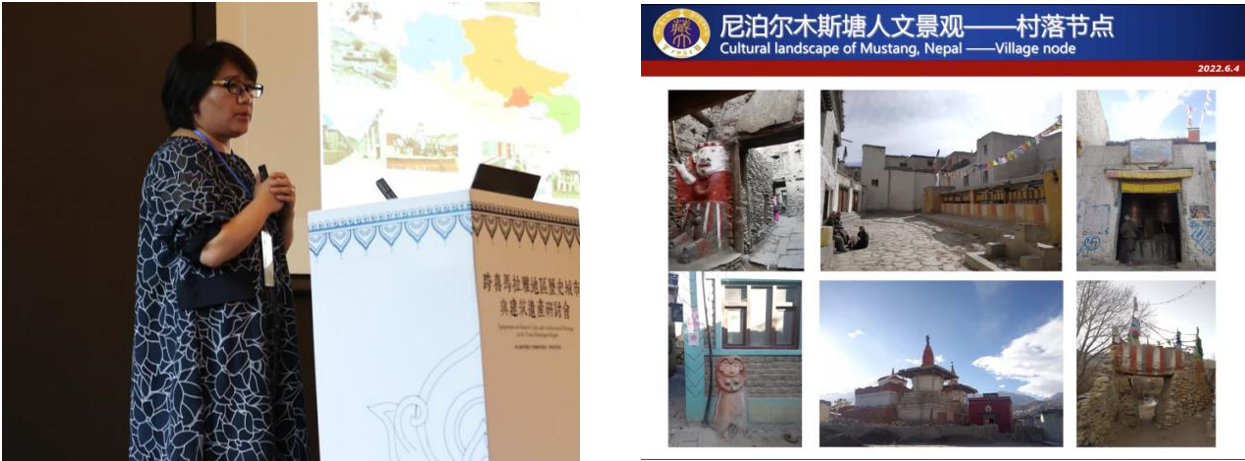 |
| Fig.9 Professor Suolang Baimu From the Institute of Technology, Tibet University is Giving Report |
The content of the report comes from the results of the project
Research on Regional Cultural Phenomenon under the Influence of Tibetan Culture in the Southern Himalayas, a cooperation project between Tibet University, China and Tribhuvan University, Nepal. As pointed out by the Prof.Suolang Baimu, Luomantang, the capital of Mustang, is very similar to the historic cities in Tibet in terms of its natural and cultural geographical environment, as well as the difficulties faced in heritage management. Thus, the experiences of the two cities in heritage conservation can be learned from each other. Having continuously focused on the living environment of Cijiaolin Village in Lhasa for the past five years, Prof.Suolang Baimu’s research team found that the architectural space of the residential buildings is closely related to the traditional lifestyle, but the village has been demolished and an industrial park has been built instead, which triggered a thinking about the disconnection between the theory and practice of local heritage conservation. It is proposed to solve the contradiction between cultural heritage conservation and people’s life, and the key is to protect the human settlement environment with the principle of integrity and positivity. Therefore, sustainable development, organic regeneration, innovative inheritance and characteristics maintenance should be taken as the theoretical starting point, basic concepts and important principles in the conservation of Mustang and Tibetan traditional settlements.
8. Wang Xihui, Understanding the Local Context of Heritage Assessment: Application and Reflection of the Historic Urban Landscape Approach in the Historic City of Myau U, Myanmar
 |
| Fig.10 Dr.Wang Xihui From the Department of Architecture, School of Spatial Planning and Design, Zhejiang University City College is Giving Report |
In the current field of heritage conservation, the Historic Urban Landscape (HUL) method remains in the experimental stage, and contextualizing the approach in relation to local heritage discourses and the dynamics of heritage governance still requires more adaptive assessment tools. Mrauk-U in Rakhine State, Myanmar, as a living historic city with traditional multi-ethnic and multi-culture, demonstrates an ecological urban landscape. Due to the fact that its heritage conservation is at an early stage, it provides an opportunity to observe the long-term implementation of the HUL approach. This study reproduced the spatial evolution of the city using a participatory historical map translation method (PHMT), identified key elements that influenced the structure of the historic urban landscape as urban heritage, and used the urban geographic information system (GIS) combined with the Analytic Hierarchy Process (AHP) in the three-step assessment of heritage value, availability and vulnerability, which indicated conservation planning principles and recommendations. The research results re-interpreted the core value of Mrauk-U's multicultural heritage, initially established a dynamic heritage management framework that meets local needs and is highly operable, specified priorities in heritage management, and provided methodological reference for the contextualization of the HUL approach.
9. Md. Masood Imran, The Yantra of Bhaktapur, Nepal: Unfolding the Spatial Distribution of Deities to Understand the Pattern of The Ancient Urban Landscape
 |
Fig.11 Professor Md. Masood Imran From Department of Archaeology
Jahangirnagar University, Bangladesh is Giving Report |
Bhaktapur is a town of devotees where people start their days from the doorways worshipping. It is called
Kumar puja. For every step taken, there are temples, and the households are even formulated with the Baudhayana Grihya-sutra. The urban space of this town is full of temples, which instigated understanding of the relationship between the spatial distributions of temples to develop the urban space of Bhaktapur. This urban space was developed and designed by the Mollar rulers as a unified town. Historically, it has been proved that they were fond of “tantrism”. Bhaktapur was developed as an urban space based on the “yantra”. Another objective of this research is to unfold the ancient space distribution pattern in Bhaktapur town, which provides the faith-based-mental-power to survive in this high earthquake-prone area. At the end of this paper, the transnational (e.g. UNESCO, ICOMOS) catagorisation of the cultural heritage of Bhaktapur, especially neglect of the ancient urban landscape pattern in trans-Himalayan region, was questioned.
10. Bob Hudson, The Jatakas: Stories of Buddha's 550 Previous Lives as Told on Glazed Ceramic Plaques, and Their Significance as Design Features of the Architecture of 11th to 14th Century Bagan
 |
| Fig.12 Dr.Bob Hudson From Asian Studies Program, University of Sydney, Australia is Giving Report |
The Jatakas are stories of Buddha’s previous lives. At 11
th to 14
th century, Bagan’s several major buildings feature terracotta or glazed plaques that illustrate these 547 or so stories as key features of their exterior design. Although the process of religious donation is described in hundreds of inscriptions at Bagan, the plaques are not specifically mentioned. The reporter tried to deduce from the architecture the possible rules for making, presenting and viewing these exterior plaques.
















Comment